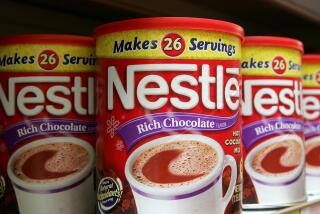Dark chocolate makes sweet comeback in ’09
Reporting from Chicago — After stalling in early 2009, the dark chocolate market finished the year with a 9% increase in sales.
Not bad for an industry that many analysts thought would see demand from recession-weary consumers melt away, particularly amid higher prices for cocoa beans and predictions of a shortage in the world cocoa harvest. In the first two months of 2009, dark chocolate sales were off 2.2%.
Although consumers started to pull back on unnecessary spending, they found ways to treat themselves. Economists call it the “lipstick factor,” referring to the historical rise in lipstick sales during tough economic times as women look for an affordable way to cheer themselves up. In the candy industry’s case, during the recession people sought chocolate as an affordable indulgence to feel better.
“There is no [vacation], but people stay at home and find small moments of joy,” said Tim Quinn, vice president of trade development at Mars Inc.
Candy sales as a whole increased 3.6% last year, with 2,843 new products introduced to the market. About two-thirds were chocolate products, according to the National Confectioners Assn., which is holding its annual candy and snack show at McCormick Place in Chicago through Thursday.
Now, as the nation emerges from the recession, candy makers hope that consumers will continue to indulge themselves. If they do, new products will be waiting.
Paul Pruett, chief executive of Bubble Chocolate, started selling his chocolate infused with tiny air bubbles about seven months ago. The aerated chocolate, which sells for about $2.50 to $3 a bar, starts out dry and tasteless; as it melts, the taster’s mouth is coated with either milk or dark chocolate.
Pruett believes that consumers are ready for innovative chocolate products. “Americans are more brave now and are trying new things,” he said.
Dark chocolate saw the greatest demand in 2007, when sales peaked at $829 million, a 35% jump from the previous year. Then the recession hit, and the pace of sales growth slowed in 2008 to 12%, according to the National Confectioners Assn.
Eric Bochner, owner of Bochner Chocolates, said the recession put a big dent in his sales. So he decided to adapt his products to the pocketbook-conscious market.
During the premium-chocolate boom, his sales increased 50%. Then sales decreased 30% from 2008 to 2009. He decided to develop new products and redesign the packaging. He infused his chocolate with flavors that were more familiar to consumers, such as cherry and hazelnut, and sold the new product at reasonable prices, about $3.50 a bar.
It worked. Bochner says sales are increasing, and he’s expecting to reach pre-recession levels later this year.
Bigger companies also are experimenting with new flavors.
In March, Hershey Co. introduced Kit Kat Dark, which used to be produced as a limited-edition bar.
Hershey acknowledged the economy’s impact on its sales, calling itself recession resistant, not recession proof. But the company’s wide portfolio gives consumers many options and many prices to choose from, said Anna Lingeris, a company spokeswoman.
In April, the chocolate maker reported that first-quarter sales increased 13.9%, as the candy maker’s U.S. market share grew by half a percentage point.
Green & Black’s, an organic chocolate maker owned by Britain’s Cadbury, which was acquired by Northfield, Ill.-based Kraft Foods Inc. this year, created a peanut-and-sea-salt chocolate bar for American consumers. It was introduced to the market at the end of 2009.
It was the first time the British brand created a flavor specifically for the U.S. market, said Katie Butler, senior brand manager for Green & Black’s USA. The flavor is doing so well that it’s expected to reach British consumers at the end of this year, Butler said.
Like the rest of the industry, Green & Black’s sales slowed in the last two years. But the brand continued to make a profit, Butler said. “People enjoy small indulgences,” she said.
More to Read
Inside the business of entertainment
The Wide Shot brings you news, analysis and insights on everything from streaming wars to production — and what it all means for the future.
You may occasionally receive promotional content from the Los Angeles Times.










